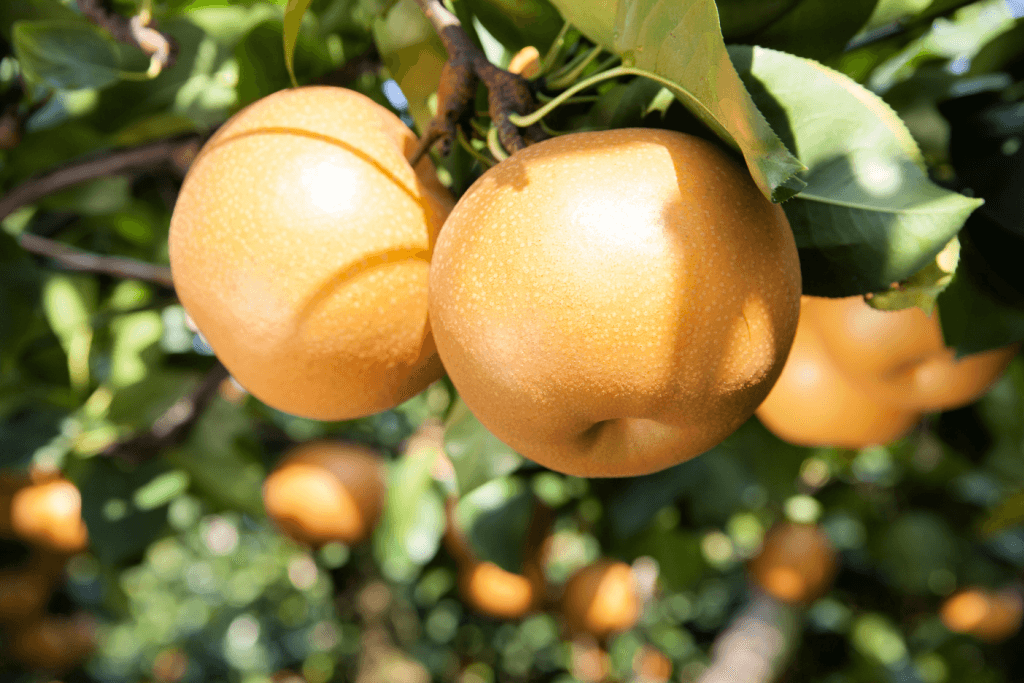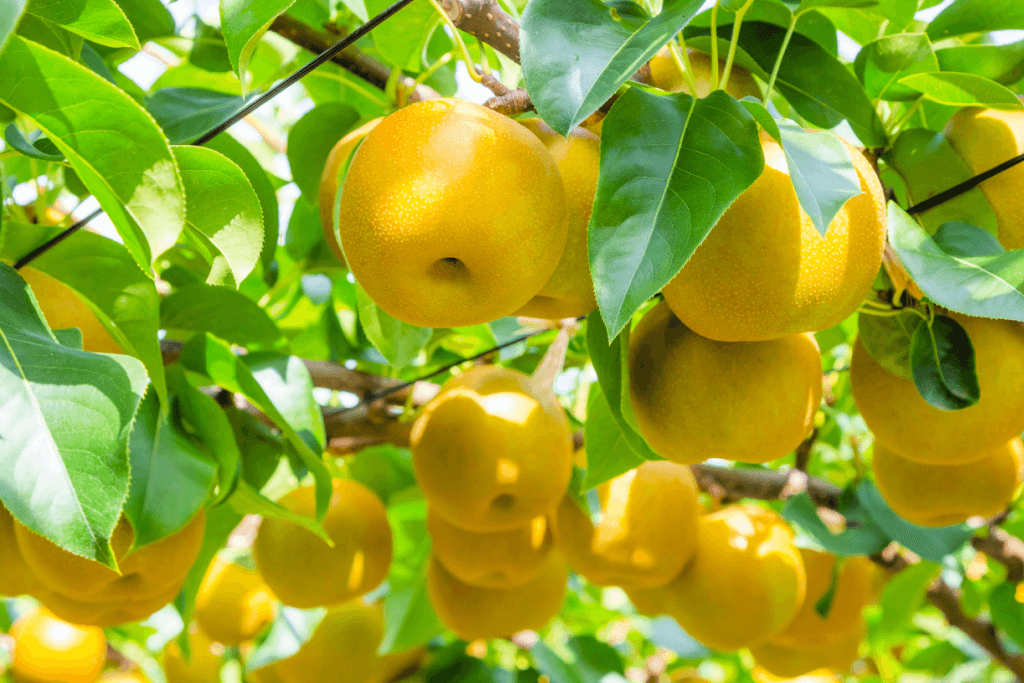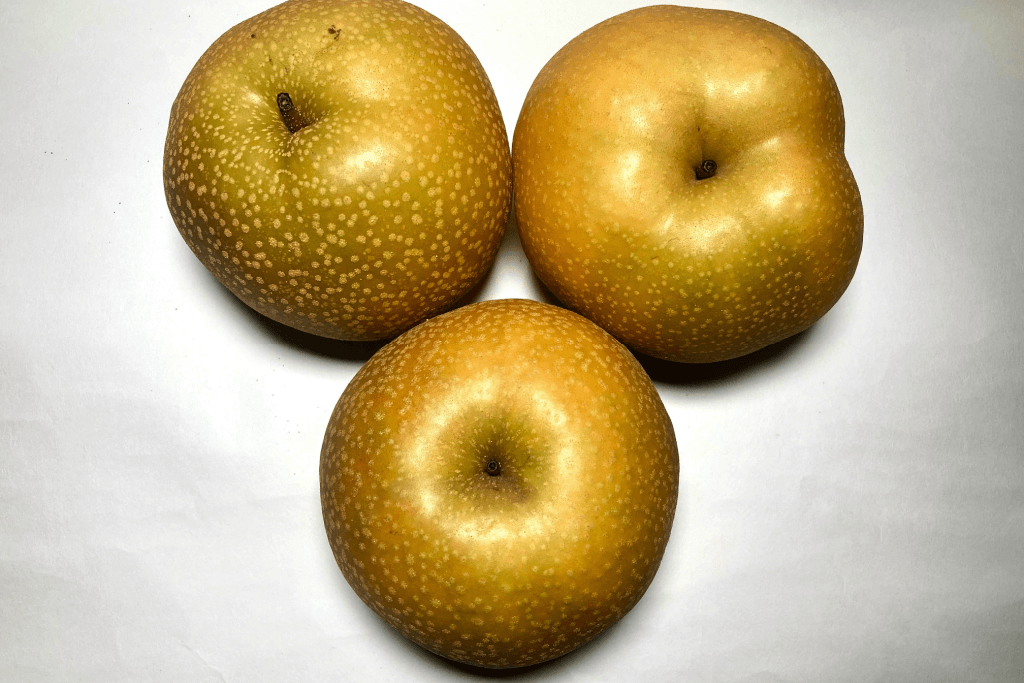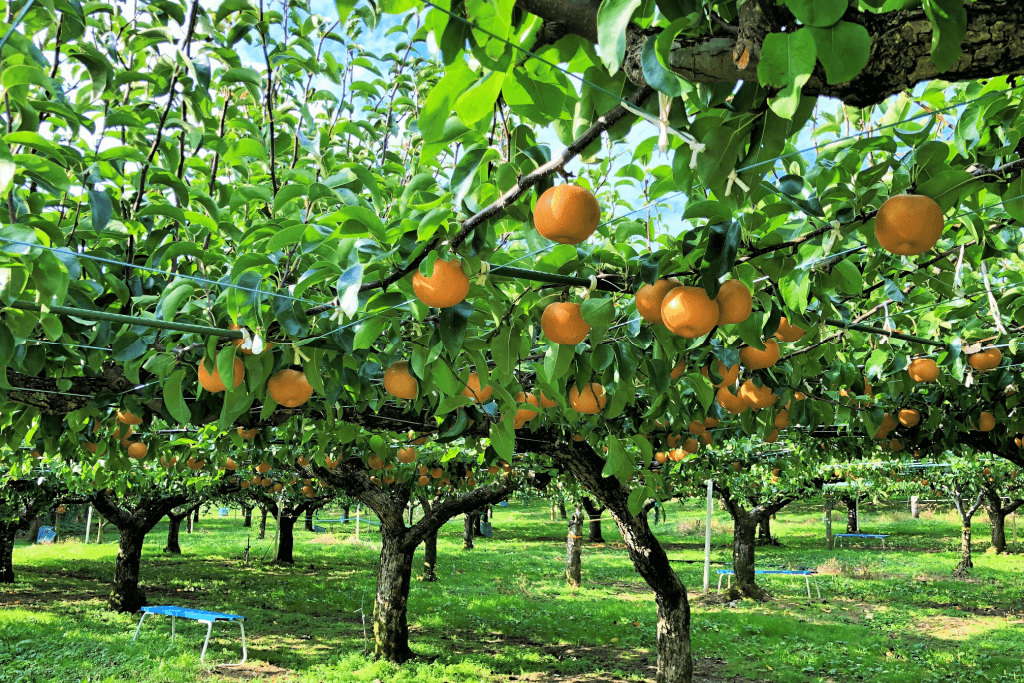pear blossoms, pear trees, Saigyoku pears
Pear Trees in Saitama: Why Are Saigyoku Pears So Good?

Savannah Walker
Posted on November 07, 2023
Share:

Have you ever heard of Saigyoku pears? Pear trees in Saitama are a world unto themselves, where nature weaves its magic to create something truly extraordinary. As we wander through the orchards of this scenic Japanese prefecture, we discover the captivating tale of Saigyoku pears.
What are pear trees like in Japan?
First, to grasp the essence of Saigyoku pear trees in Saitama, explore the world of pears in Japan. Understanding these trees is key. Japan, a land famous for its precision and dedication, has also elevated pears to the status of a luxury item.
Pears here are not mere fruits; they are a testament to meticulous care and unparalleled quality. Unlike in many Western countries, Japanese pears are grown with an almost artistic approach. Moreover, Japanese pears are a shining example of consistency.
They are a testament to the meticulous care and attention that characterizes Japanese agriculture. With uniformity in size, shape, and flavor, these pears differentiate themselves from their international counterparts. Moreover, the sheer precision in their cultivation speaks to the nation’s unwavering reverence for the fruit and its potential.

One remarkable practice that sets Japanese pear cultivation apart is the individual wrapping of each fruit. Carefully wrapping each pear in paper protects the fruit from blemishes and environmental damage. Not to mention, focusing on detail reflects Japan’s cultural value of perfection and excellence in every aspect of life. It’s not just about fruit quality.
Because of this, Japanese pears are not just agricultural products; they also mirror Japan’s commitment to excellence and perfecting nature’s produce for culinary art. Without a doubt, Saitama’s Saigyoku pears epitomize this dedication in every delightful bite.
What makes Saigyoku pears unique?
Amongst Japan’s esteemed pear varieties, Saigyoku pears stand as an exquisite example of nature’s craftsmanship. These pears, named after the Japanese word for “jade,” are prized for their stunning emerald-green skin and exceptional taste. The essence of Saigyoku pears lies not only in their size and appearance but also in their unparalleled flavor and texture.
Because farmers grow them with the utmost care, Saigyoku pear trees produce consistently large fruits, giving them an air of grandeur. Specifically, the flesh of a Saigyoku pear is remarkably juicy and incredibly sweet, a perfect blend of juiciness and sugary delight. When you hold a Saigyoku pear, you can’t help but be in awe of its flawless exterior, reminiscent of a precious gem. These pears embody the essence of luxury, providing an experience of unrivaled indulgence.

Generally, Saigyoku pears are a product of meticulous care and traditional Japanese techniques. The fruit trees are then pruned with great precision, and each pear is individually wrapped in paper to protect it from external factors, ensuring an unblemished, pristine appearance. This level of attention to detail undoubtedly sets Saigyoku pears apart from other pear varieties.
Moreover, the Saigyoku pear trees are famous for their unique grafting techniques, which contribute to the consistent size and quality of the fruit. The grafting process also involves carefully attaching a Saigyoku bud to the rootstock, resulting in the remarkable fruits that grace our tables.
Are you interested in enjoying snacks with delicious fruits like Saigyoku pears? Check out Sakuraco! Sakuraco delivers traditional Japanese snacks, teas, sweets, and snacks from local Japanese makers directly to your door so you can enjoy the latest treats directly from Japan!
Which farm grows the best Saigyoku pears?
Our quest for the finest Saigyoku pears leads us to Imai Farm in Saitama. By and large, this revered farm has a rich history of growing the best pears in Japan. For generations, they’ve perfected the art of cultivating these exceptional fruits.
All in all, Imai Farm’s commitment to quality and craftsmanship is apparent from the very first sight of its lush orchards. Their time-honored cultivation methods are the foundation of their success, allowing them to produce Saigyoku pears that are second to none consistently.
What else should I know about Imai Farm’s pear trees?
The Imai Farm’s legacy as a guardian of tradition and quality is a testament to their dedication to preserving the techniques passed down through the generations. As a result, these methods are not just agricultural practices; they reflect Japanese culture, which holds tradition and heritage in high regard.
They know the soil and climate well, creating an environment ideal for each pear. Additionally, perfect conditions and their commitment ensure exceptional quality. Every pear is nurtured with utmost devotion in this sanctuary.

The Imai Farm is not merely a place of agriculture; it is also a symbol of the Japanese spirit, where nature and tradition merge to produce the epitome of pear perfection. Each Saigyoku pear that emerges from their orchards is a testament to the farm’s dedication, making it the perfect place to experience the pinnacle of pear cultivation.
Overall, when it comes to Saigyoku pears, the Imai Farm’s legacy continues to thrive, providing a taste of Japan’s rich agricultural heritage and unwavering dedication to excellence. With each visit to their orchards, you can experience the heart and soul that go into crafting these exquisite fruits. It’s a journey that takes you beyond taste and texture, allowing you to savor the history and tradition of Japanese pear cultivation.
Why should I try Saigyoku pears?
Saigyoku pear trees in Saitama represent a testament to the art of Japanese fruit cultivation. These regal pears, grown with meticulous care and unmatched dedication, are a treasure waiting to be savored. Have you ever had the privilege of indulging in the exquisite Saigyoku pears, or have you explored the Imai Farm? We’d love to hear your thoughts and experiences. Share your pear stories, or if you’re yet to discover these remarkable fruits, let us know your thoughts below!

Discover authentic flavors with Sakuraco
Get Sakuraco 

Discover authentic flavors with Sakuraco
Get Sakuraco 
Related Articles

Japanese Fish Bait: The Beautiful Art of Kebari
Kebari are traditional hand-tied flies used for freshwater fishing in Japan, especially in mountain streams where small insects form the main diet of native fish. Instead of bright plastic lures, kebari use feathers, thread, and natural materials to create subtle movements in the water.

Japan Holidays Guide: Relax, Explore, and Delight in Festive Fun
As the year draws to a close, everywhere buzzes with preparations for the holidays, and Japan is no exception. Despite the cold winter weather, you can feel warmth in the scenery, decorations, and festive activities across the country. Let’s explore the unique experiences of holidays in Japan that many people dream of enjoying at least once in their lifetime!

Tokyo Gardens: Five Beautiful Traditional Japanese Gardens to Visit
Tokyo gardens offer a relaxing escape for visitors looking to get a breath of fresh air. However, Tokyo has more than just the typical gardens we see in the West. Let’s explore five traditional Japanese gardens and what makes them unique!

Japan Cruise Spotlight: The Ultimate Guide to Abashiri Icebreaker!
Japan offers a diverse range of cruise experiences, taking in various stunning landscapes. But, in the chilly grip of winter, some voyages pull in adventurers from around the globe. At the forefront of these wintry trips is the Abashiri Icebreaker Cruise in Hokkaido.



